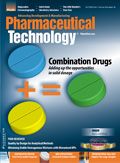Early Development GMPs for Small-Molecule Specifications: An Industry Perspective (Part V)
IQ Consortium representatives explore and define common industry approaches and practices for applying GMPs in early development.
The authors, part of the International Consortium on Innovation and Quality in Pharmaceutical Development (IQ Consortium), explore and define common industry approaches and practices when applying GMPs in early development. A working group of the consortium aims to develop a set of recommendations that can help the industry identify opportunities to improve lead time to first-in-human studies and reduce development costs while maintaining required quality standards and ensuring patient safety. This article is the fifth paper in the series and focuses on specifications.
The International Consortium on Innovation and Quality in Pharmaceutical Development (IQ Consortium) was formed in 2010 as an association of over 25 pharmaceutical and biotechnology companies with a mission to advance science-based and scientifically-driven standards and regulations for medicinal products worldwide. In previous issues of Pharmaceutical Technology, papers written by the IQ Consortium's "GMPs in Early Development Working Group" described the desire and rationale for more clear and consolidated recommendations for Good Manufacturing Practices (GMPs) in Early Development (Phase 1 through Phase 2a) (1–4). In this issue of Pharmaceutical Technology, the IQ Consortium presents a proposal for the analytical assessment and control of both drug substances (DS) and drug products (DP) in early development specifications. These recommendations take into consideration the differences in clinical trials in early development versus those in later development and provide a starting point to stimulate discussion on specifications in early development.
Previous industry position(s) on the topic of science-based specifications have not addressed early development needs or differentiated the role of specifications in early versus late development (5). During preclinical and early development, the primary focus is to progress the product into the clinic for safety and preliminary efficacy assessment. Due to the high attrition rate in early development, consistent specifications that ensure patient safety are desirable. During late development, specifications evolve as the clinical focus expands from safety to include efficacy, and as the product and corresponding synthetic and formulation process undergo significant transformations (e.g., synthetic route changes during scale-up, evolution of dosage forms from fit-for-purpose to robust formulations and processes suitable for commercial manufacturing). Therefore, early development specifications should also focus on those tests and acceptance criteria determined to be critical for the control of product quality with an emphasis on patient safety and supported by preclinical and early clinical safety studies.
CLICK TABLE TO ENLARGE Table I: Propose specification for clinical drug substance (DS) for use in early development.
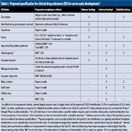
Based on the cumulative industry experience of the members of this IQ working group, the authors of this paper have proposed standardized early phase specification tests and acceptance criteria for both DS and DP, which are discussed herein. In addition to release and stability tests, consideration is given to internal tests and acceptance criteria that are not normally part of formal specifications. These tests can be performed to collect information for product and process understanding, or to allow for tighter control (i.e., target criteria tighter than the release testing criteria), to ensure product quality will be maintained throughout the product's retest period. Based on the information obtained in early development, additional tests and acceptance criteria for other attributes (e.g., water content) can be included as the late development focus shifts to process and product performance and consistency; eventually aligning with the available ICH guidelines (6).
The scope of this position paper has purposely been limited to traditional small molecules that are formulated into solid oral dosage forms intended for US regulatory filings with the desire to build consistency across all worldwide regulatory regions. However, it is believed that the concepts presented can be easily adapted to other dosage forms and routes of administration. Although designed as an industry proposal, it is recognized that each company needs to evaluate these DS and DP specification recommendations based on their individual business needs.
Proposed drug substance specifications
The DS used in the first-in-human (FIH) enabling GLP drug safety studies, referred to in this article as the "tox batch," is a fundamental part of the product lifecycle in defining the specifications for an early phase clinical DS. For the DS used in the tox batch, internal targets rather than formal specifications are routinely used while gathering knowledge about impurities, structural identification, process purging capabilities, rework processing procedures, and potential impact to the safety study. The DS tox batch is typically subjected to a series of tests to confirm description, identity, potency, and purity. The main goals are to:
- Ensure that the correct DS is administered to the test animals (often done via a spectroscopic analysis such as nuclear magnetic resonance or infrared)
- Determine the correct potency value of the DS to ensure the proper dosing of the animals
- Quantitate impurities for toxicology qualification.
For DS intended for clinical studies, additional testing and controls beyond those used for the GLP toxicology lot testing may be required. The testing may be similar to the DS tox batch, but with established acceptance criteria. In early development, the depth of knowledge regarding the synthetic route is still evolving and the DS has not been fully characterized. Accordingly, the initial clinical acceptance criteria are often based on target specifications (see Table I), with the safety limits established from the tox batch being evaluated during the disposition process of the GMP clinical DS. If the tox batch is also inten
ded to be used in a clinical study, there is an advantage in that the qualification of impurities for the clinical studies is inherently assured. In this case, the formal specification for clinical disposition of the DS may be established based on the results of tox batch testing. To further highlight the differences in expectations for early phase DS specifications, the authors propose a standardized set of clinical DS specification attributes in the following sections.
Description. Description, or appearance, is a test describing the visual attributes of the DS. Although technically simple in terms of the test, it can be the subject of much discussion due to potential discrepancies in visual observations from analyst to analyst. Important aspects of this specification are to ensure that there is no visible contamination or anomalous appearance within the DS. The recommended early phase acceptance criteria is often a somewhat broad range of colors (e.g., "white to almost-white to light yellow powder") because there is typically little batch history in early development related to the color of the DS. If it is known that the DS has an inherent color, the specification should be adjusted accordingly.
Identification. At least one form of discerning chemical identification (ID) testing is performed in the early clinical release DS specifications. This testing ensures that the drug being dosed is traceable to the same chemical entity that was qualified in the safety studies. A single ID test by a spectroscopic method such as IR is often employed. Often, the spectroscopic method compares the DS with a known batch that has been well characterized by several analytical methods.
Counterion. The counterion, if present, often is a relatively large percentage of the DS and as such is important to understand the overall potency. The recommended acceptance criteria is "report results" while batch data is accumulated and the variability of the analytical methods is assessed. If the DS is sensitive to extreme counterion levels (e.g., changes in hygroscopicity), internal targets may be implemented to prospectively alert the internal product development team of any potential issues.
Assay. Assay is a critical DS component used to determine the accurate dosing concentration for the corresponding clinical DP. The recommended range is 97.0% to 103.0% (wt/wt on a corrected anhydrous basis) based on typical assay variability for an HPLC-UV method and an acceptable accuracy range required for the early phase clinical studies. This range may be modified with justification for particular circumstances that require a wider acceptance range (e.g., elevated levels of a qualified impurity). In the absence of a reference standard, which may be the case for the initial DS lot, the assay value may be derived by using an assigned chemical potency factor that takes into account related substances, residual solvents, moisture, counterion, and inorganic impurities present.
Impurities and degradation products. Controlling organic impurities and degradation products through the DS specification is required during all stages of drug development, except in initial microdose studies. As discussed, understanding the profile of impurities qualified in the Tox batch is crucial to establishing acceptance criteria for impurities in early phase clinical DS. It is also important to monitor degradation products and impurities present in the clinical DS which may not have been qualified in toxicology studies.
In early phase development, there is limited exposure to the clinical candidate and low numbers of individuals participate in these early clinical studies. The risk to patient safety is relatively low compared to late stage development (7, 8). Therefore, this IQ working group proposes controlling impurities in early stage DS at levels that are three times (3X) higher than those defined in ICH Q3 guidelines (9, 10). As clarified in the preamble of these guidance documents, the ICH impurity guidelines are intended for pharmaceuticals approaching the point of final commercial application submission. It is inappropriate to apply these commercial ICH expectations during early clinical development based on the shorter duration of exposure during these earlier clinical studies. This 3X ICH recommendation for DS impurities in early development translates to a qualification threshold for individual impurities being three times the commercial ICH Q3A limit. Specifically, the early phase DS impurity qualification threshold is proposed to be 0.5% or 3 mg per day intake, whichever is lower, for a maximum daily dose ≤ 2 g/day. It is recognized that individual companies within industry may choose to apply different impurity qualification thresholds in early development based on an assessment of safety in the context of the individual development program.
CLICK TABLE TO ENLARGE Table II: Example of drug substance (DS) impurity scenario data in early development.
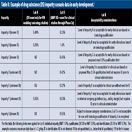
Similarly, an identification (ID) threshold of three times the ICH Q3A limit (0.3%) is proposed for unknown impurities that have not been qualified by toxicology studies. This ID threshold can be set higher for unknown impurities that have already been qualified. It is expected that as development progresses, impurities would be assessed from a toxicological perspective, appropriately qualified as necessary, and the relevant specifications updated accordingly. Later in development (Phase 2b and beyond), when a larger patient population is exposed to the clinical candidate for longer durations of time, the DS specifications for unqualified impurities should be narrowed to approach the limits outlined in the commercial ICH guidelines. Table II provides examples of various impurity scenarios to illustrate the utilization of the proposed early clinical identification and qualification thresholds and their potential impact on the acceptability of several example DS lots. All of the included examples assume a maximum daily dose of < 2 g/day and that the individual impurities are nongenotoxic.
For individual impurities that exceed the 0.5% threshold but are supported by toxicology data, an upper limit of not more than (NMT) 1.0% in the DS is appropriate for this stage of development. In some situations, an upper limit greater than 1.0% can be justified if the impurities are qualified at a higher level or if it is evident that the specific compound is also a known metabolite. In either case, a close review of the impurity profiles is required to ensure the quality of the clinical lot(s) is appropriate for the intended use and comparable based on projected exposure levels to the tox lot impurity profile. This may be triggered through the use of internal targets with alerts corresponding to the identification or qualification levels discussed above. For total impurities, the acceptance criterion often correlates with what is known about the individual impurities. An upper limit of 3.0% for total impurities is proposed as suitable for this stage of development. However, a higher upper limit for total impurities may be justified if there are a number of qualified impurities present in the DS.
Chiral impurities. Chiral impurities are usually held to the same criteria as any other impurity or degradation product with a known structural identification, leading to a proposed specification of NMT 1.0%. However, the target limit for the minor enantiomer can vary based on understanding of its pharmacological activity, toxicological qualification, metabolism pathway, and purging capabilities of the synthetic process. Sometimes it is difficult to determine the absolute chiral purity of a DS that has multiple chiral centers due to chromatographic separation challenges. For these molecules, specific rotation can be used to monitor the chiral purity in early as well as late development. Another acceptable approach to controlling chiral impurities in the DS is to monitor the chiral purity of the starting material or at an intermediate stage, where the corresponding isomers can be readily prepared and chiral chromatographic methods developed.
Residual solvents. The early development specifications for residual-solvent control are often set using the ICH established limits, including the consideration of maximum daily dose for Class 2 solvents (Option 2) (11). If the residual-solvent levels are likely to exceed the ICH limits, the specification limits in early development may be set higher than these ICH limits if they are realistically based on the manufacturing process capabilities and if there is low toxicity potential (e.g., Class 3 solvents that form solvates with the DS). In lieu of setting the standard ICH acceptance criteria, evaluation of known safety data are normally provided and justified by the appropriate drug-safety organization. It is also common practice to only set acceptance criteria on non-Class I solvents used in later steps of the synthetic process (e.g., final recrystallization and last synthetic steps) while assuring all solvents are purged through internal/characterization testing of intermediates and/or final DS.
Other internal/characterization tests
In addition to the specification tests already described, there are several tests routinely performed but not included in the specifications that are designed to gather information on the DS as the compound advances through process and analytical development. These tests are often linked to process consistency, and in early phase development there is sometimes a temptation to set wide limits based on limited manufacturing experience. Instead, it is recommended to gather data through internal/characterization testing as manufacturing experience is gained. These tests may become part of the formal specifications when meaningful limits can be introduced based on experience with the compound. These additional characterization tests are discussed below.
Potential mutagenic impurities. Limits for mutagenic or potentially mutagenic impurities have been the subject of much discussion among the industry because ICH is currently drafting its M7 guideline on this topic (12). While the landscape for this class of impurities continues to evolve, the recommendation is to follow existing guidances, such as the 2007 CHMP Guideline on the Limits of Genotoxic Impurities, until ICH M7 is finalized (13).
Inorganic impurities. Inorganic impurities are typically monitored via Residue on Ignition (ROI) and heavy metals tests using US Pharmacopeia (USP) General Chapters <281> and <231>, respectively. The recommendation for ROI in early development is an internal specification of NMT 1.0% with the knowledge that this specification may be tightened as development progresses. The current USP heavy metals test is not typically sensitive to many of the metals used in an DS synthetic route and is also currently scheduled to be retired in the near future. As such, residual metals are often monitored internally by inductively coupled plasma–mass spectrometry (ICP–MS) or ICP–atomic emission spectroscopy (OES), or some other metal specific test. The recommended limits for these metals are those set forth in EMA guidance (14). This guidance provides classifications and permitted daily exposures (PDEs) for many of common metal catalysts and metal reagents. Limits for metals not contained within this guidance should be discussed with the internal product development team and appropriate drug safety organization.
Water content, polymorphic forms, and particle size. The proposed internal specifications for water, polymorphic form and particle size distribution (PSD) are all "report results" for compounds in early development. For water content, there is normally limited information available about a compound's sensitivity to moisture in early development. Although it is important that data be collected, initially the acceptance criteria should be "report results" unless the product quality is known to be sensitive to water. In the case where the DS is a known hydrate or shown to be hygroscopic, a target water content range is typically established in the DS specification.
X-ray diffraction, Raman, and solid-state NMR can be used to monitor the polymorphic form of the DS. Because the polymorphic form can impact on solubility, stability, and bioavailability, any change in form is typically monitored during stability studies.
Particle-size distribution (PSD) can be crucial to the ability to formulate the DS into the desired dosage form. In early development, many of the formulations are relatively simple (e.g., powder in a bottle) and the PSD information is normally gathered for development purposes only as an internal test. However in certain cases (e.g., low dose tablets, inhaled products), it is worth considering a suitable PSD target which is normally set in collaboration with the formulation development group.
Other tests to consider. Other tests may be considered as additional specification tests or non-specification tests for data collection purposes. For example, certain physicochemical properties of the DS, such as pH of an aqueous solution, melting point/range, and refractive index may be considered depending on the physical nature of the DS and its intended use. Similarly, there may be a need to specify the total count of aerobic microorganisms, the total count of yeasts and molds, and the absence of specific objectionable bacteria (e.g., Staphylococcus aureus, Escherichia coli, Salmonella, Pseudomonas aeruginosa) in the DS. If so, these should be suitably determined using pharmacopeial procedures.
Proposed DP specifications
Quality attributes that affect DP performance are typically not known during the early stages of drug development. Regulatory specifications should focus on ensuring that accurate and reproducible dosing can be achieved in the clinic and that patient safety is not compromised. For many tests, it is important that characterization data be acquired, reported, and monitored to gain an understanding of the DP in the context of characterizing chemical, processing, and packaging sensitivities. As product development continues, the DP formulation and process, along with the corresponding analytical methods usually undergo significant changes. The specifications evolve as additional knowledge is gained (e.g., tightening or widening acceptance criteria, adding tests).
As mentioned in the introduction to this paper, the authors have purposely limited the scope to oral dosage forms with an emphasis on US filings. The following sections outline proposed specifications for powder-in-bottle (PIB), powder-in-capsule (PIC), and tablets and capsules used in early development.
Powder-in-bottle and powder-in-capsule specifications. The PIB formulation is the simplest presentation of a DP for early clinical trials. It involves extemporaneous compounding of the DS into a solution or suspension for oral administration. The development of PIB requires a solubility assessment of the DS and selection of a pharmaceutically acceptable vehicle based on the expected clinical dose range. The DP is then manufactured by weighing the DS into appropriately sized bottles for reconstitution with the chosen vehicle at the clinical site. With the selection of PIB for clinical trials, the product development resources and timelines can be reduced significantly as there is no formal formulation development and thus additional analytical testing for stability, content uniformity, and dissolution are not necessary.
Because only neat DS is weighed into the bottles, the specifications for the release of the DS can be readily used to release the DP. Thus, the results of the appearance and identification tests used initially for releasing the DS can be used for the DP as well. Similarly, the initial impurity results for the DP are normally taken from the DS release data and the degradation products are monitored as part of the recommended DP stability assessment. For PIB assay, the 90.0–110.0% range covers the typical variability observed in fill weights for this formulation. A stability study of the reconstituted PIB is normally conducted to support its use at the clinical site within the recommended storage conditions, as well as holding and dosing times.
Verifying the uniformity of the dosage units is recommended as an internal specification test only. In PIB cases where it is intended to be weighed at the clinical site, a simple weight check during release testing assures that sufficient DS is contained in the bottle. This weight check may be omitted from the DP specifications if it is conducted as part of an in-process control. In cases where the entire contents of the PIB are to be used to make the clinical dosing solution and only a small amount of material (e.g., 1–2 mg) is provided in the bottle, then a more suitable quantitative analytical technique (e.g., a chromatographic method) may be required to verify the accuracy of the dosing concentration.
Similar to PIB, the PIC formulation is another simple presentation of neat DS in a capsule. PIC also provides dosing flexibility but has the added advantage of allowing easy manufacture of matching placebos. The only major difference in its development process compared with PIB is that a compatibility study of the DS with the capsule shell should be done to select a suitable capsule.
CLICK TABLE TO ENLARGE Table III: Proposed specifications for powder-in-bottle (PIB) and powder-in-capsule (PIC).
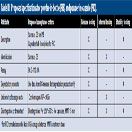
The typical PIC specification tests used in early development are comparable to those used for PIB formulations (see Table III). Specifically, appearance, identification, and assay all rely on the DS release results. Uniformity of PIC dosage units is performed according to USP General Chapter <905> but it can be omitted as a regulatory specification if it is part of an in-process control. In addition, disintegration test per USP General Chapter <701> is recommended to ensure that the capsules rupture to allow the release of the drug for absorption.
Tablet and capsule specifications. In early development, tablet and capsules for oral administration often employ "fit-for-purpose" formulation approaches designed to be suitable for wide classes of compounds, with the ultimate goal of facilitating rapid entry into FIH clinical trials. In the case of tablets and dry fill capsules (DFC), these formulations often employ a dry blend or granulations of a nonreactive diluent, a disintegrant, and a glidant to aid in processing. As shown in Table IV, standardized specifications are frequently established for capsules and tablets that are used in early development that can be segregated into the following attributes:
Description and identification: Visual description of the dosage form and correct identification of the active dose are critical to the integrity of the clinical study and thus are important attributes to be included in the DP specifications. The appearance specification should note the external color and shape of the dosage form. A single discerning identification test is normally sufficient and may be derived from the HPLC test used for assay or impurities based on the comparison of the sample retention time or photodiode array spectrum to that of a comparator DS batch.
CLICK TABLE TO ENLARGE Table IV: Proposed specifications for tablets and capsules.
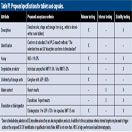
Assay: An assay specification of 90.0–110.0% is normally attainable and controllable for most tablet and capsule formulations used in early development and ensures dosage integrity and patient safety. Additionally, this acceptance criteria provides reasonable formulation process control while accounting for typical assay variability and formulation inconsistencies in early development given the higher levels of impurities/degradation products normally observed at this stage.
Impurities and degradation products: Similar to the earlier proposal for DS, it is proposed that identification and qualification thresholds of three times those listed in ICH Q3B guideline (regardless of maximum daily dose), be applied for both impurities and degradation products in DP in the early stage. The proposed limit for unspecified individual degradation products in early development is NMT 1.0%. The limit of 5.0% for total degradation products in early phase DPs is higher than the corresponding limit of 3.0% for total impurities in DS due to the additional variability contributed by the formulation excipients, DP manufacturing process, and DP analytical methods.
In early development, these limits are justified because clinical studies are of limited size and duration and stability information on early drug candidates with respect to sensitivities to moisture, hydrolysis, and oxidation is still being acquired. Later in development, process control, formulation design, and product protection strategies to minimize product degradation can be implemented after the compound sensitivities are better understood and thus tighter degradation product controls are justified.
Uniformity of dosage units: The uniformity of active material in dosage units is important to the integrity of the clinical trial and to patient safety. The guidance for acceptance values is defined in USP General Chapter <905>. These acceptance criteria set a minimum standard for batch homogeneity and should be attainable at all stages of development for both capsules and tablets.
Water content: As described for DS, a DP specification only needs to be established to control moisture levels in an investigational capsule or tablet dosage if the product quality or performance is known to be sensitive to water. As development progresses and additional knowledge is attained about product performance and stability in the presence of water, a specification may be applied, as necessary for release, shelf life, or both.
Dissolution and disintegration: For rapidly dissolving immediate release formulations, it is recommended to include disintegration as a regulatory filed specification. Dissolution may be performed as an internal specification (i.e., report results without defined acceptance criteria) to gather product knowledge during early development (e.g., for poorly soluble drugs). As additional knowledge is gained toward establishing an in-vitro–in-vivo correlation (IVIVC), dissolution acceptance criteria should be established in later development (i.e., Phase 2b and beyond).
Other tests to consider. Other tests may be added to the DP specification as required. For example, residual solvents should be tested if solvents are used in the DP manufacturing process. Similar to DS, microbial testing may be considered, although a risk assessment may be performed to justify not including this test in the specification for solid oral dosage forms in early development.
Some in-process control tests such as hardness and/or friability may have a critical impact on drug product quality (e.g., chewable tablets). In these cases, acceptance criteria should be included in the specification.
Conclusions
A standard, risk-based approach has been presented for setting DS and DP specifications in early development for conventional solid oral dosage forms intended for US regulatory submissions. The recommendations herein are aimed at ensuring patient safety while allowing the flexibility to adapt to the frequent product and process changes that occur early in development. The authors' goal is to promote clarity and consensus within the pharmaceutical industry and to establish a more detailed approach to specifications in early development that are aligned across the industry and regulatory agencies. To further stimulate discussions on these approaches within the industry and with worldwide health authorities, this IQ working group is planning on conducting a workshop in the near future to promote robust debate and discussion on these proposed specifications in early development. In closing, it is recognized that each company needs to evaluate these early development recommendations based on the objectives of their individual drug development programs and may choose not to adopt this industry proposal on phase appropriate specifications.
About the Authors
Michael Coutant works in Analytical Research and Development at Pfizer Inc. (Groton, CT); Zhihong Ge works in Analytical Chemistry at Merck & Co. Inc. (Rahway, NJ); James S. McElvain* works in Analytical and QC at Kythera Biopharmaceuticals (Calabasas, CA); Scott A. Miller works in Analytical and Bioanalytical Development at Bristol-Myers Squibb Company (New Brunswick, NJ); Dennis O'Connor works in Quality & Records Management and Frank Swanek works in Analytical Development, both at Boehringer Ingelheim Pharmaceuticals Inc. (Ridgefield, CT); Michael Szulc works in Analytical Development at Biogen Idec (Cambridge, MA); Mark D. Trone works in Analytical Development–Small Molecule at Millennium Pharmaceuticals, Inc. (Cambridge, MA); Kirby Wong-Moon works in Analytical Research and Development at Amgen Inc. (Thousand Oaks, CA); Mehran Yazdanian works in Pharmaceutical Development at Teva Global Branded Products R&D (West Chester, PA); Peter Yehl works in Small Molecule Analytical Chemistry and Quality Control at Genentech (South San Francisco, CA); and Shuhong Zhang works in Process R&D, Global Pharmaceutical R&D at Abbott Laboratories (North Chicago, IL).
*To whom all correspondence should be addressed.
References
1. A. Eylath et al., Part I, Pharm. Technol. 36 (6) 54–58 (2012).
2. D. Chambers et al., Part II, Pharm. Technol. 36 (7) 76–84 (2012).
3. R. Creekmore et al., Part III, Pharm. Technol. 36 (8) 56–61 (2012).
4. B. Acken et al., Part IV, Pharm. Technol. 36 (9) 64–70 (2012).
5. P. Kurtulik, Pharm. Technol. 31 (4) 156–169 (2007).
6. ICH, Q6A Chemical Substances (ICH, Geneva, 1999).
7. L. Müller et al., Regul. Toxicol. Pharmacol. 44, 198–211 (2006).
8. ICH, S9 Nonclinical Eval. for Anticancer Pharm. (ICH, Geneva, 2009).
9. ICH Q3A(R2) Impurities in New Drug Substances (ICH, Geneva, 2006).
10. ICH Q3B(R2) Impurities in New Drug Products (ICH, Geneva, 2006).
11. ICH Q3C(R5) Impurities: Guideline for Residual Solvents (ICH, Geneva, 2011).
12. ICH, M7 Assess. and Control of DNA Reactive (Mutagenic) Impurities in Pharma. to Limit Poten. Carcin. Risk (Draft) (ICH, Geneva, 2012).
13. CHMP, Guideline on the Limits of Genotoxic Impurities (EMA, 2007).
14. CHMP, Guideline on the Spec. Limits for Resid.of Metal Catal. or Metal Reagents (EMA, 2008).
